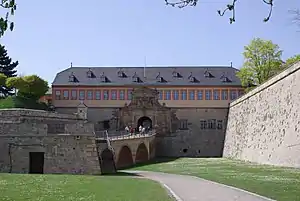Coercion castle
A coercion castle[1][2][3] (German: Zwingburg) or coercive castle[4][5] was a heavily fortified, medieval castle built to dominate the surrounding land. Such castles were built mainly in the High and Late Middle Ages in order to protect those territories in areas where the population was not assessed as being entirely loyal to the sovereign. Because of the poor infrastructure of medieval Europe, the construction of castles was one of the most important ways of exercising power, which is why it was governed by royal rights (known as regalia). Examples of coercive castles are the Moritzburg in Halle, which was built in the late 15th century, and the Alte Burg in Koblenz.
Gallery
 Moritzburg (Halle)
Moritzburg (Halle) Alte Burg (Koblenz)
Alte Burg (Koblenz) Petersberg Citadel (Erfurt)
Petersberg Citadel (Erfurt) Veste Oberhaus (Passau)
Veste Oberhaus (Passau) Forte Spagnolo (L’Aquila, Italy)
Forte Spagnolo (L’Aquila, Italy) Castello di San Giusto (Triest, Italy)
Castello di San Giusto (Triest, Italy)
See also
References
- A Concise History of Brandenburg-Prussia to 1786 by Otis C. Mitchell, University Press of America, 1980, p. 3
- The Soldier Kings: The House of Hohenzollern by Walter Henry Nelson, Putnam, 1970, p. 24
- Peace in the Western World by Matthew Melko, John Hord, McFarland, 1984, p. 29
- Turko-Mongol Rulers, Cities and City Life by David Durand-Guédy, Boston: Brill, 2013, p. 359
- Sources concerning the hospitallers of St John in the Netherlands: 14th-18th Centuries by J.M. Van Winter (ed.), Leiden: Brill, 1998, p. 795
External links
| Look up coercion castle in Wiktionary, the free dictionary. |
This article is issued from Wikipedia. The text is licensed under Creative Commons - Attribution - Sharealike. Additional terms may apply for the media files.
